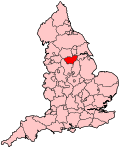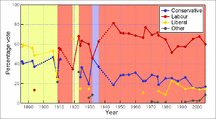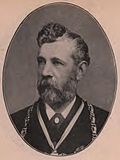| Sheffield Attercliffe |
|---|
Former Borough constituency
for the House of Commons |
 Boundary of Sheffield Attercliffe in South Yorkshire for the 2005 general election |
 Location of South Yorkshire within England |
| County | South Yorkshire |
|---|
| 1885–2010 |
|---|
| Replaced by | Sheffield South East |
|---|
| Created from | Sheffield |
|---|
Sheffield Attercliffe was a parliamentary constituency in the City of Sheffield. It was created at the 1885 general election and abolished at the 2010 general election, when it was replaced by a new Sheffield South East constituency.
Boundaries
1885–1918: The Municipal Borough of Sheffield wards of Attercliffe and Park, and the civil parish of Heeley.
1918–1950: The County Borough of Sheffield wards of Attercliffe and Darnall.
1950–1955: The County Borough of Sheffield wards of Attercliffe, Darnall, and Handsworth.
1955–1974: The County Borough of Sheffield wards of Attercliffe, Darnall, Handsworth, and Tinsley.
1974–1983: The County Borough of Sheffield wards of Attercliffe, Birley, Darnall, Handsworth, and Mosborough.
1983–2010: The City of Sheffield wards of Beighton, Birley, Darnall, Handsworth, Mosborough, Richmond and Woodhouse.
Note: there were council ward boundary changes in 2004, which abolished Handsworth and created Beighton, Mosborough, Richmond and Woodhouse.
From 1997, Sheffield Attercliffe covered much of the east and south-east of the city. It bordered the constituencies of North East Derbyshire, Rotherham, Rother Valley, Sheffield Brightside, Sheffield Central and Sheffield Heeley.
History
Sheffield Attercliffe constituency was created when the two-seat Sheffield constituency was split into five single-member seats in 1885.
Members of Parliament
Elections

Sheffield Attercliffe election results
Elections in the 2000s
General election 2005: Sheffield Attercliffe[1] | Party | Candidate | Votes | % | |
| | Labour | Clive Betts | 22,250 | 60.10 | -7.69 |
| | Liberal Democrats | Kevin Moore | 6,283 | 16.97 | +2.76 |
| | Conservative | Tracy Critchlow | 5,329 | 14.40 | -0.80 |
| | UKIP | Jonathan Arnott | 1,680 | 4.54 | +1.74 |
| | BNP | Beverley Jones | 1,477 | 3.99 | New |
| Majority | 15,967 | 43.13 | |
| Turnout | 37,019 | 54.59 | |
| | Labour hold | Swing | -5.22 | |
General election 2001: Sheffield Attercliffe[2] | Party | Candidate | Votes | % | |
| | Labour | Clive Betts | 24,287 | 67.8 | +2.5 |
| | Conservative | John Perry | 5,443 | 15.2 | -0.9 |
| | Liberal Democrats | Gail Smith | 5,092 | 14.2 | -1.5 |
| | UKIP | Pauline Arnott | 1,002 | 2.8 | New |
| Majority | 18,844 | 52.6 | +3.6 |
| Turnout | 35,824 | 52.9 | -11.8 |
| | Labour hold | Swing | | |
Elections in the 1990s
General election 1997: Sheffield Attercliffe[3] | Party | Candidate | Votes | % | |
| | Labour | Clive Betts | 28,937 | 65.3 | +7.8 |
| | Conservative | Brendan Doyle | 7,119 | 16.1 | −10.2 |
| | Liberal Democrats | Gail Smith | 6,973 | 15.7 | +1.0 |
| | Referendum | James Brown | 1,289 | 2.9 | New |
| Majority | 21,818 | 49.2 | +18.0 |
| Turnout | 44,318 | 64.7 | -7.1 |
| | Labour hold | Swing | | |
General election 1992: Sheffield Attercliffe[4] | Party | Candidate | Votes | % | |
| | Labour | Clive Betts | 28,563 | 57.5 | -0.3 |
| | Conservative | Gordon Millward | 13,083 | 26.3 | +3.6 |
| | Liberal Democrats | Helen Wooley | 7,283 | 14.7 | -4.8 |
| | Green | Gordon Ferguson | 751 | 1.5 | New |
| Majority | 15,480 | 31.2 | -3.9 |
| Turnout | 49,680 | 71.8 | -1.1 |
| | Labour hold | Swing | | |
Elections in the 1980s
Elections in the 1970s
Elections in the 1960s
General election 1966: Sheffield Attercliffe | Party | Candidate | Votes | % | |
| | Labour | John Hynd | 32,336 | 77.3 | +10.5 |
| | Conservative | Brian Marsden | 9,511 | 22.7 | +0.2 |
| Majority | 22,825 | 54.6 | +10.3 |
| Turnout | 41,847 | 67.6 | -4.4 |
| | Labour hold | Swing | | |
General election 1964: Sheffield Attercliffe | Party | Candidate | Votes | % | |
| | Labour | John Hynd | 30,318 | 66.8 | -2.0 |
| | Conservative | Herbert Lambert | 10,223 | 22.5 | -8.8 |
| | Liberal | Colin Wood | 4,831 | 10.7 | New |
| Majority | 20,095 | 44.3 | +6.8 |
| Turnout | 45,372 | 72.0 | -3.3 |
| | Labour hold | Swing | | |
Elections in the 1950s
General election 1959: Sheffield Attercliffe[7] | Party | Candidate | Votes | % | |
| | Labour | John Hynd | 33,676 | 68.8 | -2.2 |
| | Conservative and National Liberal | Herbert Lambert | 15,304 | 31.3 | +2.3 |
| Majority | 18,372 | 37.5 | -4.5 |
| Turnout | 48,980 | 75.3 | +3.2 |
| | Labour hold | Swing | | |
General election 1955: Sheffield Attercliffe[8] | Party | Candidate | Votes | % | |
| | Labour | John Hynd | 33,071 | 71.0 | -0.1 |
| | Conservative and National Liberal | Herbert Lambert | 13,503 | 29.0 | +0.1 |
| Majority | 19,568 | 42.0 | -0.2 |
| Turnout | 46,574 | 72.1 | -10.6 |
| | Labour hold | Swing | | |
General election 1951: Sheffield Attercliffe[9] | Party | Candidate | Votes | % | |
| | Labour | John Hynd | 29,958 | 71.1 | -0.5 |
| | Conservative and National Liberal | Herbert Lambert | 12,161 | 28.9 | +0.5 |
| Majority | 17,797 | 42.2 | -1.0 |
| Turnout | 42,119 | 82.7 | -3.7 |
| | Labour hold | Swing | | |
General election 1950: Sheffield Attercliffe[10] | Party | Candidate | Votes | % | |
| | Labour | John Hynd | 30,726 | 71.6 | -9.8 |
| | Conservative and National Liberal | Lionel Farris | 12,185 | 28.4 | +9.8 |
| Majority | 18,541 | 43.2 | -19.6 |
| Turnout | 42,911 | 86.4 | +7.0 |
| | Labour hold | Swing | | |
Elections in the 1940s
General election 1945: Sheffield Attercliffe | Party | Candidate | Votes | % | |
| | Labour | John Hynd | 23,468 | 81.4 | +12.6 |
| | Conservative | Brian Paddon | 5,376 | 18.6 | -18.6 |
| Majority | 18,092 | 62.8 | +37.2 |
| Turnout | 28,844 | 79.4 | +6.4 |
| | Labour hold | Swing | | |
The 1944 by-election was called following the resignation of Cecil Henry Wilson on 9 February. John Burns Hynd of the Labour Party was elected unopposed.
Elections in the 1930s
Elections in the 1920s
General election 1929: Sheffield Attercliffe | Party | Candidate | Votes | % | |
| | Labour | Cecil Wilson | 19,152 | 60.3 | -3.3 |
| | Unionist | Wilfred Barnard Faraday | 6,190 | 19.5 | -16.9 |
| | Liberal | Thomas Neville | 4,652 | 14.7 | New |
| | Communist | George Fletcher | 1,731 | 5.5 | New |
| Majority | 12,962 | 40.8 | +13.6 |
| Turnout | 31,725 | 75.4 | -0.5 |
| | Labour hold | Swing | +6.8 | |
General election 1924: Sheffield Attercliffe | Party | Candidate | Votes | % | |
| | Labour | Cecil Wilson | 16,802 | 63.6 | +4.9 |
| | Conservative | Wilfred Barnard Faraday | 9,629 | 36.4 | +10.0 |
| Majority | 7,173 | 27.2 | -5.1 |
| Turnout | 26,431 | 75.9 | +9.1 |
| | Labour hold | Swing | | |
General election 1923: Sheffield Attercliffe | Party | Candidate | Votes | % | |
| | Labour | Cecil Wilson | 13,581 | 58.7 | -9.5 |
| | Unionist | George Terrell | 6,106 | 26.4 | New |
| | Liberal | Harry Briggs | 3,438 | 14.9 | -16.9 |
| Majority | 7,475 | 32.3 | -4.1 |
| Turnout | 23,125 | 66.8 | -1.8 |
| | Labour hold | Swing | N/A | |
Elections in the 1910s

Thomas Casey
General election 1918 Electorate 35,923 | Party | Candidate | Votes | % | |
| C | Liberal | Thomas Worrall Casey | 12,308 | 65.3 | New |
| | Labour | William Anderson | 6,539 | 34.7 | −20.3 |
| Majority | 5,769 | 30.6 | N/A |
| Turnout | 18,847 | 52.5 | −19.6 |
| | Liberal gain from Labour | Swing | N/A | |
| C indicates candidate endorsed by the coalition government. |
By-election, 1914: Sheffield Attercliffe[11] | Party | Candidate | Votes | % | |
| | Labour | William Anderson | Unopposed |
| | Labour hold |
Elections in the 1900s
Elections in the 1890s
This by-election was called due to the resignation on 26 June of Bernard John Seymour Coleridge following his inheritance of the title of Baron Coleridge.

J. Batty Langley
Elections in the 1880s
See also
Sources
References




